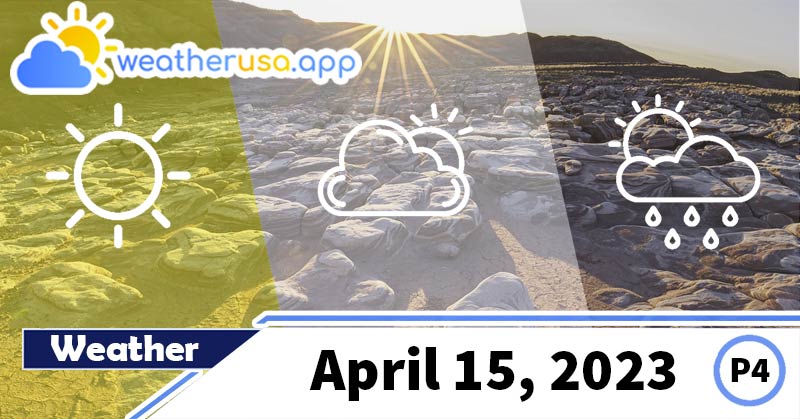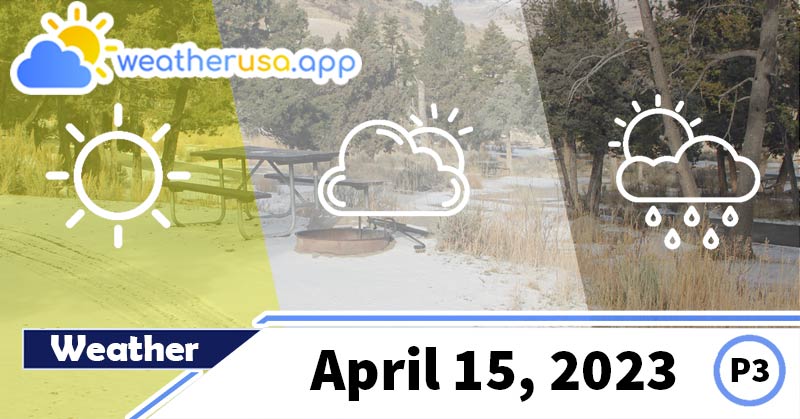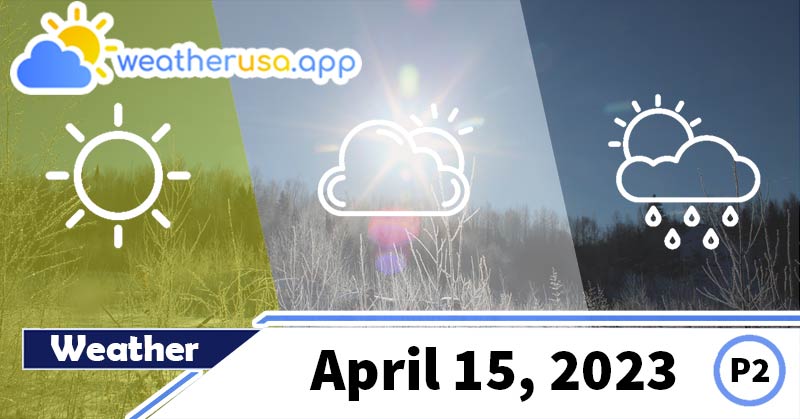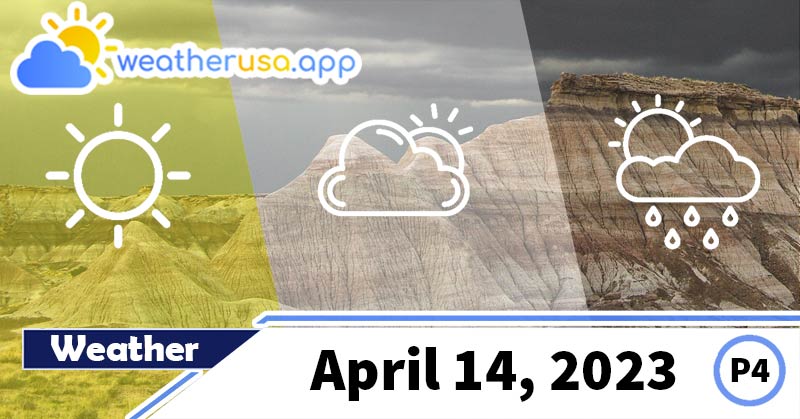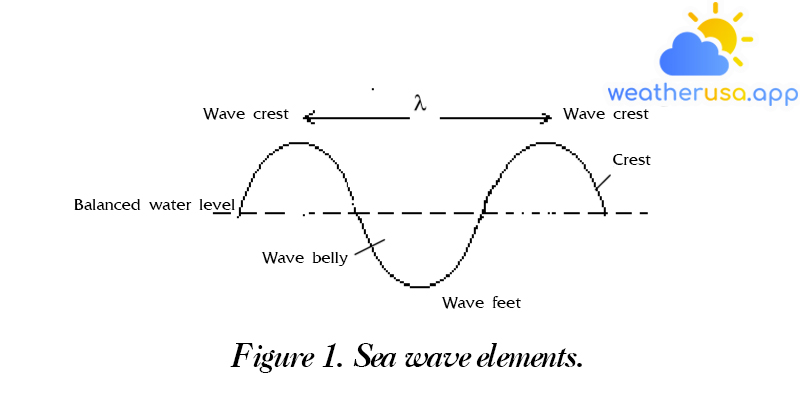
Waves
General concept
Definition of ocean waves
As a result of various natural forces acting on ocean and seawater, oscillations and forward movements of particles occur in seawater, as in any medium, called wave motion or waves in general.
When a sea wave occurs, it is understood as a motion with an ever-changing period where water particles oscillate around their equilibrium position.
When a sea wave occurs, it is understood as a motion with an ever-changing period where water particles oscillate around their equilibrium position.
When there are waves, that is, when there is a force acting on the water particles, the ocean’s surface cannot be calm.
Visually, you can say that sea waves are undulations of the sea surface. This undulation of the waves does not significantly change the sea level.
Visually, you can say that sea waves are undulations of the sea surface. This undulation of the waves does not significantly change the sea level.
Classification of sea waves
Many different characteristics classify ocean waves.
a. According to the types of forces that cause waves, i.e., according to their origin, oceans and seas are divided into the following courses:
– Wind waves, formed under the action of the wind;
– Tidal waves, appearing under the influence of the cyclical gravity of the moon and the sun;
– Gravitational waves, arising when the sea surface deviates from its equilibrium position, are caused by the effect of wind and changes in barometric pressure.
– There are earthquake waves in the earth’s crust, arising as a result of dynamic processes, which mainly underground earthquakes and, at the same time, underground eruptions and volcanoes near the sea.
– Ocean waves are born when the ship moves.
Most types of waves and tides are observed on the ocean’s surface.
b. According to the force that pulls the water particles back to their equilibrium position, they are divided into capillary waves and gravity waves. In the first case, the restoring power is surface tension, and in the second, it is gravity.
Capillary waves are small and are caused as soon as the wind begins to act on the water’s surface or the underlying gravity wavefront. At sea, gravity waves play a significant role.
c. According to the action of the force after the wave is generated, people are divided into free waves if the staff has stopped acting and forced waves if the party continues to work on the lock.
d. According to the variation of wave factors, people are divided: a standing wave, where the elements do not change over time, and an unstable wave – a growing or weakening wave in which the factors change over time.
e. Depending on the location, they are divided into surface and internal waves …
Origin, development, and extinction of waves
- Studies show that waves are created by wind, and their potential and kinetic energy are transferred to water particles by unequal pressure. Pressure unevenness is caused by swirling movements of airflow, i.e., wind.
- First, tiny waves are formed – capillary waves, or ripples, with a height of a few millimeters, created with a weak wind, then with increasing wind speed, gravity waves, this waveform, are made they play a dominant role in the whole lock.
Wave height and slope rise rapidly. At some point, they grow to the point where the tip of the wave is tilted forward, causing the white foam to spread out in long streaks.
The wind continued to increase until the gale force observed fast-moving waves of great length and height, causing the crests to fall toward the base of the waves.
The faster the wave movement, the larger the wave elements catch up and round off the short waves. These waves travel in many directions, and the sea level moves up without order.
This physical process is best represented as simple wave spectra of varying height, length, and frequency. So, under the action of the wind, the sea surface creates a complex system of waves with different properties.
It is explained that the wind, as it is known, is heterogeneous in its structure and enormously varies in space and time, both in speed and direction.
In other words, the wind speed and direction at different points of the sea surface at the same time are not the same and do not maintain time invariance. - The potential and kinetic energy of the wind transferred to the wave is lost mainly due to overcoming the internal friction of the water. Wind energy loss increases with wave height, so increasing wave speed decreases gradually.
After a certain period, the action of the wind causes the wave to grow to a specific limit; then, it stops as if the wind is no longer blowing. - The closer the wave propagation speed is to the wind speed, the weaker the wind pressure, resulting in less energy transfer. The correlation between wave speed and wind speed is known as wave maturation.
As long as this correlation is less than 0.5, the height of the wave increases sharply. After growth slows down, Up to magnitude 0.9, wave height and slope decrease while cycle length and speed continue to grow. - When the wind strength reaches a specific value, it is attenuated and moves away from the waves, no longer affecting the subsequent development of the waves.
This explains why during a big storm, the highest and most dangerous waves for ships are observed not when the wind blows the strongest but 4-6 hours after its onset hissed. - The difference in wave propagation speeds leads to their convergence. During a big storm, it is possible to accidentally encounter a large moving mountain of water, which is especially dangerous for ships.
Several waves of roughly the same size create a more significant wave due to interference. Hence the legend of the “big wave area” is that during big storms, there are usually stronger waves in the area of solid wind than elsewhere. In reality, the lock is not stable; the distribution of its elements is random. - When the wind stops, the wave stops receiving energy, and the process of weakening begins. Small waves die out first, then more giant waves, and later the biggest waves die out and can last for several hours.
Patterns and patterns of sea waves a
a. Wind wave: transmitted at the time of observation is under the direct effect of the wind that caused it. This wind changes the shape and size of the waves.
Wind waves carried on the surface of the sea have an undulating form like mountains and pass from one wave to another. Wind waves are usually short, high, and steep. This wave can be considered a growth phase where some or all wave elements are growing.
Wind waves carried on the surface of the sea have an undulating form like mountains and pass from one wave to another. Wind waves are usually short, high, and steep. This wave can be considered a growth phase where some or all wave elements are growing.
b. Large waves: generated by the wind but no longer affected by the wind at the observation time. In this case, the wave oscillates only under the influence of gravity and weakens. Look at the lock from the outside.
The wave is transmitted in successive waves with the shape of a wake, a round wave, and a mild side wave. Large waves that pass when the wind is calm are called large dead waves.
c. Shallow water waves are waves that, when traveling in shallow seas, have a depth equal to or less than half the length of the wave. These waves will remain the same but are usually steeper and shorter.
Depth is half a wavelength, which can be approximated, and is the boundary of the transition from wind and deep to shallow water waves.
Depth is half a wavelength, which can be approximated, and is the boundary of the transition from wind and deep to shallow water waves.
d. Rolling waves are an early waveform of waves. The wavefronts are slightly wavy, like fish scales.
This wave has a minimal length and height and runs in parallel rows a few centimeters apart; the wave oscillations do not penetrate the subsurface layer and stop as soon as the wind stops blowing.
This wave has a minimal length and height and runs in parallel rows a few centimeters apart; the wave oscillations do not penetrate the subsurface layer and stop as soon as the wind stops blowing.
e. Coastal Wave: A wave with a long, foam-covered blade that forms when a wave spreads to a temperate coast.
The bottom friction catches the lower part of the wave, and the upper part reaches forward and has a great speed, so it forms long paddles of waves that hit the shore, sometimes accompanied by noise, and when the waves are strong, there can be a roar heard.
The bottom friction catches the lower part of the wave, and the upper part reaches forward and has a great speed, so it forms long paddles of waves that hit the shore, sometimes accompanied by noise, and when the waves are strong, there can be a roar heard.
Sea Wave elements
Wave elements
The following defining factors characterize each wave:
a. Wave height: the distance measured in meters vertically from the crest of the wave to the foot of the wave.


b. Wavelength is the distance measured horizontally between two consecutive wavefronts or arms.
c. The crest of the wave is the highest point of the crest, and the base is the lowest point of the belly of the wave.
d. A wave is the part of a wave above the equilibrium water level. The belly of the wave is the part of the wave below the surface of the flat water.
e. Wave slope ) – the ratio of wave height to wavelength.
– the ratio of wave height to wavelength.
f. Wave speed is the distance a wavefront moves in one second in the direction of wave propagation.
g. The wave period τ is the interval between two consecutive wavefronts passing a specific point on the sea surface.
h. Direction of wave propagation: is the angle calculated from the north point to the east to the direction from which the wave travels to.
Dependence of wave factors with different wave-forming factors
- Based on known research and experience, wave factors created by wind in oceans and seas depend on wind strength and impact length, distance traveled, bottom topography, and other factors.
If the given wind strength is different, different specific conditions can cause different sizes of wave elements. - With an increase in the strength of the wind and its duration of action with a given speed and direction, wave height, length, and other factors are observed.
This growth is not infinite; even when the wind is strong, waves reach their maximum values in oceans and deep seas about 1-2 days after wave growth stops.
Generally, as the wind gets stronger and stronger, the wave height increases rapidly. It often rises to a height of 5-8m after 5-6 hours.
About 40% of all waves have a size equal to or greater than the average, and only 2-5% – peaks, which is about two times or more above the norm. - The maximum wave for a given wind will only be seen if the distance traveled and the duration of the wind impact is significant enough and does not limit the effect of the waves.
- The depth of the sea also dramatically affects the evolution of the size of the wave elements. When the depth is less than the wavelength, the wave elements cannot reach a large extent, as in deep water, due to friction at the bottom.
- From the above, we can see that large waves can appear when the wind is not very strong in a stable direction if the wind blows continuously in a body of water of the same size and intensity at great depth.
- For coasts where depth significantly affects wave development, consideration must be given to the beach’s shape and the wind’s direction relative to the beach.
- All these characteristics of waves and undulations need to be carefully calculated in navigation.
Watch the ocean waves.
Ocean waves are observed from coastal stations and offshore – on board ships.
In maritime navigation, for the correct calculation of the effect of waves on ships, it is necessary to quickly determine other factors and characteristics of locks, to know their dependence on the wind, and to summarize the state of the waves in advance of wind on the ship’s route and also around the boat.
This allows the conductor to choose the optimal course and speed, reduced loss of speed, less splashing on board, less rolling, and no danger to ship and cargo due to wave interaction.
This allows the conductor to choose the optimal course and speed, reduced loss of speed, less splashing on board, less rolling, and no danger to ship and cargo due to wave interaction.
People observe ocean waves with the naked eye and with the help of instruments.
Observe the waves with the naked eye
A conventional wave scale is used to assess the parameters of a sea wave with the naked eye – see table 1, and to determine the wave level, type, and shape of the wave, table 2 – state of the sea level can be used.
Table 1. Classification of waves according to height.
| Wave Level | Wave height (m) | Summary of conventional characteristics of waves |
| 0 | – | Quiet waves |
| I | From 0 to 0.25 | Weak waves |
| II | 0.25 – 0.75 | Medium wave |
| III | 0.75 – 1.25 | Big wave |
| IV | 1.25 – 2.00 | Big wave |
| V | 2.00 – 3.50 | Strong waves |
| VI | 3.50 – 6.00 | Strong waves |
| VII | 6.00 – 8.00 | The waves are very strong |
| VIII | 8.00 – 11.00 | The waves are very strong |
| IX | From 11.00 and up | Unusually strong waves |
Note: Roman numerals indicate the wave level. The limits “from” and “to” are understood as follows:
“From” means including the number, and “to” does not. For example, 3.5 to 6.0 m means 3.5 msh< 6.0 m.
Table 2. Signs determining the level of sea level status.
| Sea surface status level | Signs to determine the level of sea surface state | Wind level according to Beuafort scale |
| 0 | – The water is as calm as a mirror | 0 |
| 1 | – The water surface ripples, and there are small waves. | 1 |
| 2 | – Small waves began to fall; transparent foam (like glass) but not white. | 2 |
| 3 | – You can see the small waves; some waves have foam pouring down to form white foam in some places (the first wave is white) | 3 |
| 4 | – The wave shape is visible; everywhere you can see the white head. | 4 |
| 5 | – Appears high waves, white foam crests occupy wide spaces, and the wind begins to blow foam from the waves. | 5 |
| 6 | – The wave breaks into long, wave-like blades, and the wind blows on the wave, causing foam to spread, spreading in a trail wave ridge. | 6 |
| 7 | – Long strips of foam blown up by the wind cover the side of the wave and, in some places, blend and push down to the foot of the wave. | 7 |
| 8 | – Foam covering the slopes of the waves falls in wide bands, making the sea surface white; only some places (foot area waves) are visible voids covered with foam. | 8 |
| 9 | – The entire sea surface is covered with a thick layer of foam. Air full of dust, water drops, and bubbles, visibility is reduced a lot of | 9 |
Note: sea level state is expressed in degrees from 0 to 9 and in Arabic numerals.
The standard for determining sea level is the shape of the sea surface under the influence of wind on the sea surface.
The criterion for deciding sea level is the height of high and conspicuous waves, surges, and waves in shallow water areas.
The degree of sea surface state depends on the wind strength, but with the wave level, in addition to that, strength also depends on the power of the water surface, wind speed, wind blowing time, and sea depth.
The criterion for deciding sea level is the height of high and conspicuous waves, surges, and waves in shallow water areas.
The degree of sea surface state depends on the wind strength, but with the wave level, in addition to that, strength also depends on the power of the water surface, wind speed, wind blowing time, and sea depth.
Wave level and sea level do not match. Wave level can be less than, equal to, or sometimes more significant than sea level. For example, when there is a big wave, the wind is still blowing; even if the oil intensity is low, wave level VI corresponds to the sea surface level 2.
On a ship observed with the naked eye, the wave elements have some unique features as follows:
a. Observe the direction of wave propagation. The direction of wave propagation is called one of the eight principal directions: N, NE, E, SE, S, SW, W, and NW. If two waveforms are found, the wave direction assigned to each is recorded as a fraction.
Practice observing the wave direction as follows: place the line of the compass to coincide with the direction of the moving wavefront, i.e., set the reticle along the wave crests, then rotate the sprocket 90° to meet the demand of the moving wave, and read on the waveguide graduated ring.
The reader needs to be calibrated against the compass test card. Finally, convert it to one direction whose value is closest to the reading relative to the other directions.
The reader needs to be calibrated against the compass test card. Finally, convert it to one direction whose value is closest to the reading relative to the other directions.
b. Wave height monitoring: it is necessary to determine the wave with the highest height.
If the wave height is less than the ship’s upper part, it can be determined by comparison with the side ladder.
Then, the wave height is selected, and a continuous trace of the wave crest and the wave foot at the ship’s side is determined according to the estimated projection of the wave crest onto the superstructure or the mast.People choose the 3-5 highest waves and take a maximum height to observe.
Then, the wave height is selected, and a continuous trace of the wave crest and the wave foot at the ship’s side is determined according to the estimated projection of the wave crest onto the superstructure or the mast.People choose the 3-5 highest waves and take a maximum height to observe.
In case the wave height is higher than the height above the water surface of the ship, you must stand on a specific size to see the path of the near wave crest.
Best in horizontal range when the boat is at the base of the wave. Then the eye height above the ship is equal to the wave height.
Best in horizontal range when the boat is at the base of the wave. Then the eye height above the ship is equal to the wave height.
c. Wave length monitoring. Wavelength is measured along the edge between two consecutive wave crests. If the wavelength exceeds the length of the ship’s hull, a buoy is released from the stern to stand on top of the wave when the second warhead passes through the observer.
The length of the pontoon line between the following two waves is the wavelength. If the ship is sailing against or against the waves, the measured wavelength means that the angle between the ship’s course and the direction of wave propagation is 0 or 180°.
If the wave direction makes an angle q with the longitudinal axis of the boat, then in this case, the measured lifeline length I am multiplied by cosq.
The length of the pontoon line between the following two waves is the wavelength. If the ship is sailing against or against the waves, the measured wavelength means that the angle between the ship’s course and the direction of wave propagation is 0 or 180°.
If the wave direction makes an angle q with the longitudinal axis of the boat, then in this case, the measured lifeline length I am multiplied by cosq.
For example, if the wave moves in the direction of generation with a longitudinal axis q = 30° and the length of the pontoon line measured along the edge between the two wavefronts is I = 50 m, then the wavelength.
λ = | cosq = 50 x 0.86 = 43.0 m.
d. Wave period monitoring is done in two ways:
-The observer places the tip of the scope perpendicular to the direction of wave propagation. Select the most significant wave, and determine, according to the stopwatch, the time between two consecutive wavefronts passing through the viewfinder.
That period is the apparent wave time, if the ship is in motion, the real-time – anchoring, or – floating. It should be measured thus at least 4.5 times for the most significant waves observed, then averaged.
When the ship goes against the wave, the period is smaller than the actual period, and when going against the wave, the period is larger.
That period is the apparent wave time, if the ship is in motion, the real-time – anchoring, or – floating. It should be measured thus at least 4.5 times for the most significant waves observed, then averaged.
When the ship goes against the wave, the period is smaller than the actual period, and when going against the wave, the period is larger.
Inside
q is the angle between the direction of the ship and the direction of wave propagation.
– Find a floating object on the side, and use a stopwatch to determine the consecutive time the floating object stands on two large waves. It is possible to replace floating objects with bubbles commonly found on wavefronts.
With this approach, the actual period value of the wave does not depend on whether the vessel is moving or moored.
e. Monitor the transmission speed. When the ship is moored, calculate the time t that the next two wavefronts pass through the same point on the side, or the front of the wave passes through two points on the side of the ship. The distance between these two points can be measured. Wave speed is 
When the ship travels in the direction of wave propagation, the wave propagation speed is calculated by the formula.
Where position  – train speed (m/s); “+” sign if the train is moving forward, “-” sign if the train is going backward.
– train speed (m/s); “+” sign if the train is moving forward, “-” sign if the train is going backward.
When the ship has an angle q with the direction of generation with the guidance of wave propagation, then:

f. Monitor the casino thanks to the onboard radar. Wave characteristics and strength, as well as wavelength, period, and speed, can be determined by radar. Radio signals reflected from the sea surface are clearly distinguished on the screen.
- The image of the echo from the carrier is distinct and infallible. It forms sparkling dots near the center of the screen, which change position, light, and shape with each antenna rotation.
The entire screen area is covered by wave signals, the magnitude of which depends on the strength of the wave, its characteristics, and its size. The echo zone on the screen has an oval screen.
Most of the area is on the windward side. This phenomenon is explained because the leeward side of the wave has a steep slope, giving a stronger signal than the upwind side, which has a lighter slope. - Because the wave’s ability to scatter radio energy decreases rapidly as the distance to the antenna increases, the area on the screen flickers due to the limited signal from the waves: when the waves are level 5-6, the radius to reach that area is no more than 2 nautical miles, and when living stronger, the distance is up to 3-4 nautical miles.
- Large waves on the screen can be seen at great distances. A wide range of echo levels results in an unmistakable echo signal, allowing all wave propagation directions to be seen.
- While there are no turbulence and high waves, it is sometimes possible to detect local disturbances, similar to a wave signal, but only at individual points adjacent to the forward and backward currents of the tides.
Wave characteristics in the World Ocean and nearshore areas.
- Wave factors occur under wind action over oceans and seas and its properties, as described above, depend not only on the strength of the wind but also on a range of other factors.
- In the oceans, much greater wave heights are observed than in the sea. Sea breeze waves can reach heights of 20-25 m and more excellent. Wavelength up to 400 m.
Big waves are even longer in the Atlantic Ocean, the northern part near the equator; the giant wave is 842 m long, the period is 23 seconds, and the speed is over 70 knots. - In the oceans, when the waves are regular, the height is usually 7 – 8 m, 120-150 m long, with a period of nearly 10 seconds; At sea, due to the small depth and weaker wind speed, the wave above factors will be considerable.
For example, in the Apod Sea and Baltic Sea, wave height is 3-5 m; in the Black Sea, Sea of Japan, East Sea-In China, and Sea of Okhot is 6-8 m. - At the same time, in the sea areas, it is possible to observe rising water and rising water originating from those areas first.
As a result of their mixing, turbulent waves are the most prominent feature of the ocean. Waves are pure wind found on the sea and waves – on the ocean.
Because the size and depth of the seas are not large, waves have the following characteristics:
- After the wind starts to work – high-speed wave motion reaches its maximum value, such as in the Adop Sea during a storm, the waves reach their full size in less than 1 hour, counting since the wind began to blow strong; the steepness of large waves; Wave attenuation is also rapid, along with wind deactivation.
- In the sea and ocean near the shore, waves are characterized by disorder; when entering far from the coast and leaving shallow water, the waves are more orderly.
Waves propagate in shallow water, more or less forming parallel lines. The small energy produces the waveform distortion caused by the damping of the wavelets since bottom friction increases as the depth decrease.
Simultaneously with it arises the so-called refraction of life, that is, a change in the direction of the wavefront.
Weather 01852 - Lowell MA

49°
clear sky
Feels like 46°05:46/19:39
52°F
/45°F
39%
1029 hPa
7 mi
6.91 mph
